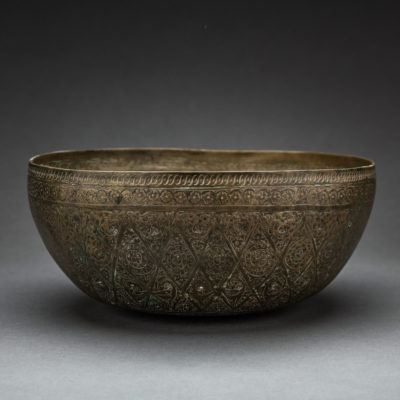
| SKU | LO.863 |
|---|---|
| Circa | 877 BC to 1187 AD |
| Dimensions | 9″ (22.9cm) wide |
| Medium | Quarternary Bronze |
| Origin | Central Asia |
| Gallery Location | UK |
Deep bowl engraved in the cavetto with a winged buraq and concentric registers on the sides filled with abstract motifs and a row of prancing felines attacking deer.
In the Islamic tradition, the buraq was a creature said to have transported the Prophet Muhammad to heaven. Described as a white animal, half- mule, half-donkey, with wings on its sides, Buraq was originally introduced into the story of Muhammad’s night journey (isra’) from Mecca to Jerusalem and back, thus explaining how the journey between the cities could have been completed in a single night. Sometimes mistakenly described as Muhammad’s horse, the buraq was a creature described as being part eagle and horse, thus resembling a pegasus. An excerpt from a Sahih Muslim hadith describes a buraq:”I was brought by the Buraq, which is an animal white and long, larger than a donkey but smaller than a mule, who would place its hoof at a distance equal to the range of vision.” In literature and art, often portrayed with the face of a woman and the tail of a peacock, the buraq is mostly visible in the sacred manuscripts, where the creativity of the artist was less hampered by religious restrictions. In both a leaf from a copy of the Bustan of Sacdi dated 1514 originally from Uzbekistan and now in the Metropolitan Museum of Art (New York), and a 16th Century manuscript of Khamsa of Nizami in the British Library (London), narrating the Mi’raj, or ascension of the Prophet, Muhammad is depicted on his steed, the buraq. The artist has painted the legendary creature prancing forward as about to take a leap into the Seven Heavens, her human face depicted frontally. Comparable anthropoid depictions of the buraq are known also from many engraved metal vessels such as this basin, dating to the Seljuq period.
Metalwork in the Near East and Central Asia has always enjoyed a prestige beyond that of other applied arts such as ceramics and textiles. Major pieces were specially commissioned and often bear dedications to the princes and great nobles for whom they were made, together with the proudly inscribed names of their makers and decorators; their very durability and impressive appearance give them a high standing and dignity of their own. The best pieces were in bronze, either engraved, inlaid, overlaid or beaten in repousse’, that is hammered out from behind of designs to appear in relief on the surface. The roots of Islamic metalwork are to be found in Byzantium and Persia. In the early 7th century the Arabs took over these two great empires and absorbed local metal techniques and typologies, and contributed to a new development in metalwork by adding inscriptions in kufic script. Not much is known of the art of metalwork in Persia and Central Asia in the early Islamic period, with the exception of few large dishes datable to the Ghaznavids, until the Seljuq period, when new forms started to appear, while lavish inlays and incrustation of gold, silver and copper crept onto the surface.
This basin was probably made of high-tin bronze, an alloy of copper and about 20 per cent tin. This alloy was known in early Islamic times as asfidroy, literally ‘white copper’ and was used for bowls, stem bowls, dishes, ewers and candlesticks. Amongst the particular properties of high tin bronze is that it can be red-hot forged, like iron, and if quenched, becomes reasonably malleable when cold. If permitted to cool slowly than hammered, it shatters. Three centres of quarternary bronze manufacture are recorded in Islamic texts of the 10th-11th centuries: Rabinjian near Bukhara, Hamadan in western Persia and Sistan province in eastern Persia. Transoxiana, i.e. Eastern Persia and Afghanistan, provided the inspiration for the Hamadan industry as well and kept on producing high-tin copper alloy vessel well into the 13th century, although with less originality than before. The quality of engraving and the patterns featured on the cavetto of our basin would seem to indicate a 12th-13th centuries dating and a Transoxiana provenance.
Login to view price
Sign-up to receive the latest Wedding Estates news and promotions!

